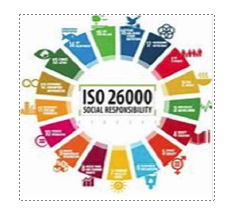Keywords: CSR, ISO 26000, Responsibility, Governance, Stakeholders
1) What is the social responsibility of an organization?
The 17 Sustainable Development Goals and their 169 targets were adopted by the 193 UN member states as part of the United Nations Sustainable Development Agenda 2030. They came into effect in January 2016. Reference site: https://www.agenda-2030.fr/
The ISO 26000 standard derives directly from these 17 goals set by the UN. It establishes guidelines for the social responsibility of organizations by defining how organizations should contribute to sustainable development. It dates to November 2010. According to this standard, “Social responsibility is the contribution of organizations to sustainable development. It translates into the organization’s willingness to take responsibility for the impacts of its decisions and activities on society and the environment, and to be accountable for them.”
An organization’s responsibility for the impacts of its decisions and activities on society and the environment is defined through 7 core principles and 7 central questions:
a) The 7 principles
- Respect for human rights
- Accountability
- Transparency
- Ethical behavior
- Recognition of stakeholder interests
- Respect for the principle of legality
- Consideration of international behavior standards
b) The 7 central questions
- Organization governance
- Contribution to local development
- Human rights
- Labor practices and conditions
- Environment
- Fair operating practices
- Consumer protection
2) What interest does an organization have in assessing its social responsibility?
Social and ethical responsibility: Organizations, especially businesses, play an increasingly important role in society. They are often held accountable for their social and environmental impact. An CSR assessment allows measuring and considering these impacts by aligning the company’s activities with high ethical and social standards, often measured by indicators.
Risk management: CSR assessment helps identify risks related to business, social, and environmental practices. By identifying and understanding these risks, companies can implement measures to mitigate them, thus reducing their exposure to potential disruptions in their operations.
Long-term value creation: Companies that integrate sustainable practices into their CSR strategy are often better positioned to create long-term value. This can result in improved company reputation, increased customer and employee loyalty, reduced operational costs, and enhanced innovation. Ultimately, this allows these companies to gain a significant competitive advantage.
Regulatory compliance: Many regions of the world have implemented strict regulations regarding responsible business practices, environmental protection, workers’ rights, etc. An CSR assessment helps companies comply with these regulations and avoid the legal and financial risks associated with non-compliance. Additionally, the arrival of the European directive CSRD (Corporate Sustainability Responsibility Directive) will be facilitated by an initial CSR assessment of organizations.
Stakeholder engagement: Stakeholders, such as employees, customers, suppliers, investors, and civil society actors, are increasingly attentive to a company’s CSR practices. A transparent and credible CSR assessment demonstrates an organization’s commitment to sustainability and strengthens trust with its stakeholders.
Other benefits: CSR assessments can unite employees around a common project and can also enhance and aggregate existing initiatives within the organization.
In summary, a CSR assessment allows organizations, including businesses, to manage their social, environmental, and economic impacts proactively. This can lead to better long-term performance and stronger relationships with stakeholders.


